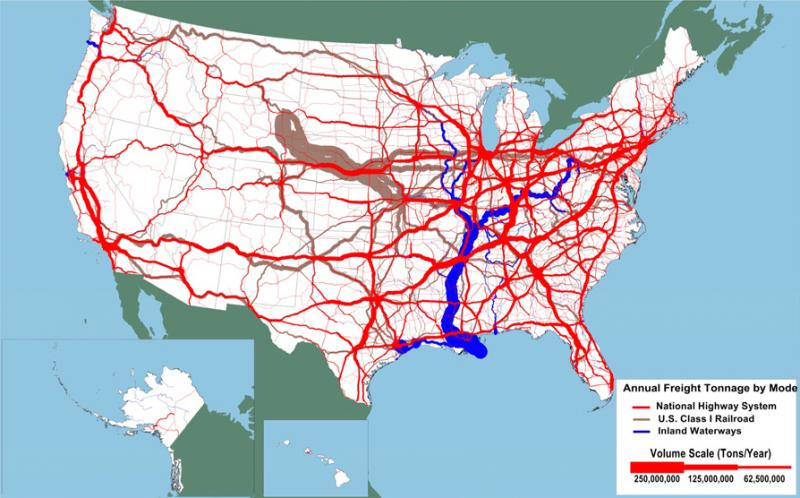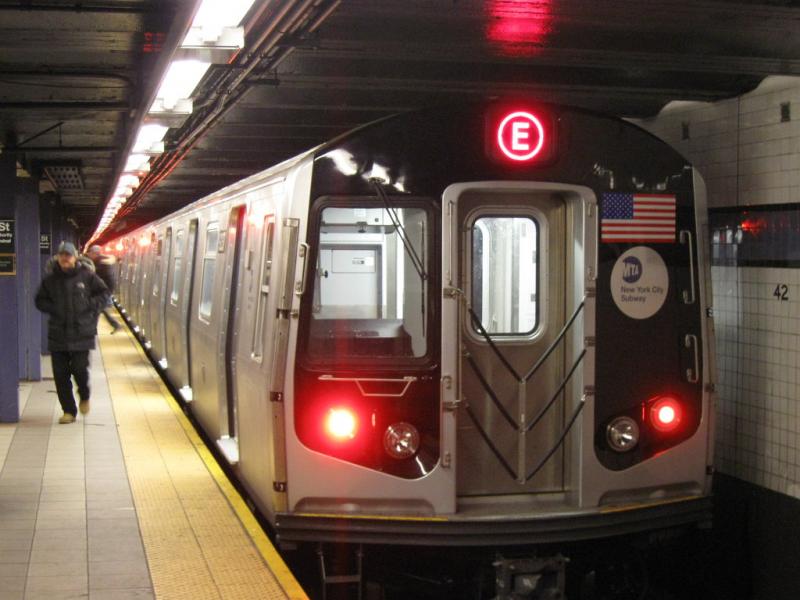
Transportation
- Extreme events associated with climate change threaten transportation systems and supply chains, potentially disrupting production and distribution networks required for consumers to access goods and services.
- Land-based transportation can be disrupted by elevated temperatures, increased extreme precipitation events, and inundation of roads from rising sea levels.
- Water-based transportation is subject to disruptions from changing water levels for inland navigation during drought and floods, and damage to coastal facilities from extreme weather events.
- Air transportation for people and cargo is subject to disruption from increased extreme weather events and elevated temperatures.
- Supply chains may be impacted by the disruption of transportation and telecommunication systems. Processes involving the extraction and delivery of raw materials or the distribution of goods can be interrupted by higher temperatures and increased frequency or intensity of extreme events.
Key points:
Threats to transportation systems and supply chain security
Climate change presents new risks to domestic and international transportation systems and supply chains. The U.S. economy depends on robust transportation systems and supply chains to efficiently and effectively distribute goods and people down a street, across the country, or around the world. Supply chains connect multiple steps within complex production systems that produce and deliver many of the goods utilized by consumers in our global economy. Climate-related disruption of these systems may result in substantial economic losses, as well as threats to the safety and welfare of populations.
The United States relies on diverse modes of transportation:
- The road system comprises approximately four million miles of mostly publicly owned roads and over 600,000 bridges. These assets serve more than 230 million personal automobiles and light trucks, 10 million heavy trucks, and more than 70,000 transit buses.1
- The rail system comprises 140,000 miles of mostly privately owned rail track, with most freight rail service provided by seven privately owned rail companies. Passenger rail service is provided by the federally owned Amtrak and a range of state and local rail service agencies.
- Public transit agencies maintain some 12,000 miles of track, supporting about 20,000 rail vehicles. They also operate about 70,000 buses, 188 ferry boats, and more than 80,000 vans and demand-response vehicles.2
- A network of privately owned pipelines convey fuels and fuel products across the country, including 300,000 miles of pipeline for natural gas, 50,000 miles of pipeline for crude oil, and 75,000 miles of pipeline for petroleum products.
- Coastal and inland waterways, largely used for freight, include a system of mostly federally operated locks and canals. These enable access to ports with diverse ownership for a mostly private fleet of 31,500 barges, 200 ocean-going U.S. flagships, and 9,000 other vessels.3
- Air transportation is facilitated by the National Airspace System, which is operated by the federal government. The system includes a network of routes, radar systems, and air traffic control centers used by 7,500 mostly private, U.S.-registered commercial airliners, foreign airliners, and more than 200,000 general aviation aircraft.
Supply chains represent a shipper’s view of the freight transportation network. The chain includes all the elements involved in transporting raw materials to processing locations and fabrication facilities, as well as those that bring finished products to vendors and final customers. With the continued development of global trade among countries, the supply chains of materials such as coffee from Africa or coconut oil from the Philippines span the whole world. As materials move from their source to processing and/or manufacturing facilities, and then to retailers and end users, interruptions in any portion of the chain can increase costs and inconvenience customers. Some supply chains are only important to the makers and users of particular products. Other chains—for example, those that supply fuel and food—are of importance to suppliers, consumers, and the economy.
Climate change increases threats to transportation systems
Weather- and climate-related events are already affecting transportation and supply chains. Impacts on the transportation system can be divided into several categories:
- Damage or destruction of key infrastructure,
- Upgrading existing infrastructure to prevent damage,
- Weather-related closure or disruption of transportation,
- Safety impacts of adverse weather,
- Health impacts on vulnerable populations from loss of access to services, and
- Changes in maintenance and operations costs for pavement or track maintenance and snow or debris removal.
Extreme precipitation, flooding, and increased temperatures have resulted in damage to roads, bridges, railroads, and other transportation facilities in inland as well as in coastal communities. As the frequency of extreme precipitation events has increased every decade since the 1950s, risks to transportation systems have increased. For instance, flooding in the Midwest during 2008 disrupted freight and rail transportation, negatively impacting businesses and communities that depend on reliable shipments of materials and products. In addition, coastal communities have faced increased costs due to damage from extreme storms and rising sea levels: these events have damaged roads, ports, and other infrastructure. An estimated 60,000 miles of coastal highways are already exposed to periodic coastal storm flooding and wave action exacerbated by rising sea levels.4
Climate scientists project that current trends will result in higher temperatures, increased frequency of severe precipitation events, longer and/or more frequent droughts, increased sea levels, and an increased frequency of strong hurricanes. Some regions may experience temperature increases of 15°Fahrenheit above current conditions—these higher temperatures have the potential to affect transportation and supply chain infrastructure such as roads and railways. Regional changes in precipitation patterns can result in lower and higher water levels, impacting river navigation for waterborne freight as well as roadway crossings of streams and rivers. Increases in sea level for most of the United States may inundate transportation and supply chain infrastructure in the coastal zone. For the Gulf Coast alone, sea level rise may inundate roads, railroads, airports, and seaports, impacting economic activities valued at hundreds of billions of dollars. Damage from sea level rise may be exacerbated by an increase in the frequency of Category 4 and 5 hurricanes.
Individuals, businesses, and government entities can take action to increase the resilience of transportation and supply chains to extreme events. Advance preparation and adaptation can help avoid disruptions and minimize impacts. Better planning for infrastructure and site selection, the use of weather-resistant building materials, increased redundancy of transportation components, and improved post-disruption recovery planning can provide more security for transportation systems and supply chains.
This section is excerpted and abridged from the report Climate Change Impacts in the United States: The Third National Climate Assessment, Chapter 5: Transportation.
To learn more about the impacts of climate change and variability on transportation and supply chains, visit the subtopic pages:
- 1. U.S. Department of Transportation, Bureau of Transportation Statistics, posted April 2015: National Transportation Statistics.
- 2. American Public Transportation Association, 2014: 2014 Public Transportation Fact Book. 68 pp.
- 3. U.S. Army Corps of Engineers, Navigation and Civil Works Decision Support Center, 2015: The U.S. Waterway System: Transportation Facts & Information. 12 pp.
- 4. Natural Research Council of the National Academies, Transportation Research Board and Division on Earth and Life Studies, Committee on Climate Change and U.S. Transportation, 2008: Potential Impacts of Climate Change on U.S. Transportation. Transportation Research Board Special Report 290, 280 pp.




